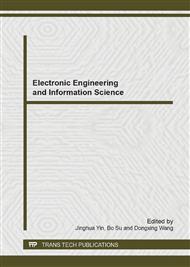p.319
p.323
p.327
p.331
p.335
p.340
p.344
p.348
p.352
Video Segmentation Algorithm Based on Improved Kirsch Edge Operator and Three-Frame Difference
Abstract:
For the most commonly used method of are susceptible to noise, it is difficult to extract a complete moving target . Aiming at this problem, we propose a video segmentation algorithm through the combination of an improved Kirsch edge operator and the three-frame difference. Firstly, we got a moving region through a differential by the three consecutive image frames, and then got the edge on the current frame using an improved Kirsch edge detection operator, Synthesis of the two test results, we got a more accurate moving object edges. Then using the edge connector algorithm to complete the connection of the fracture edge, and finally, got moving target mask image through regional filling, thereby dividing the complete moving target, thus dividing the complete moving target. Experimental results show that the algorithm has a certain robustness, and can accurately detect moving targets.
Info:
Periodical:
Pages:
335-339
Citation:
Online since:
July 2014
Authors:
Price:
Сopyright:
© 2014 Trans Tech Publications Ltd. All Rights Reserved
Share:
Citation:


